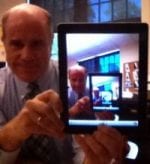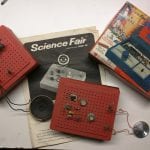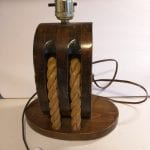Growing up in the pre-digital age, my childhood was rich with free time and a relationship with the technology around me that felt accessible. I loved to tinker and my toys—erector sets, tool box, and chemistry set—encouraged me to so. I took apart radios, phones, and anything else I could get my hands on. My Boy Scout handbook, Popular Science and Boy’s Life magazine were my guides, and Radio Shack was my hub, with shelf upon shelf of kits and components that taught me about electronics, fostered experimentation and allowed me to invest in producing my own playthings.
The collapse of a store like Radio Shack signaled to me the end of an era.
In the move from an agrarian society to an industrial one and industrial to electronic, average users could still maintain analog technology. Fix the plow, change the spark plugs, rewire the lamp, solder the ham radio…. When something broke, with some basic understanding, we could at least figure out what had broken even if we couldn’t fix it, and we passed this knowledge down to each generation in home kitchens and garages and fortified it in schools with courses like Industrial Arts (where I wood-crafted and built my own lamp) and Home Economics. We did hobbies in our spare time and learned skills separate from their professional or school lives.
- A closing local Radio Shack
- Inside a closing local Radio Shack
- Some of my old Radio Shack kits
- Knot tying in my old Boy Scout Handbook
- The lamp I made in 8th grade Industrial Arts
Now, with the tech boom, the age of cheap manufacturing, and the development of a disposable consumables, the need to develop that accessible relationship with technology has fallen out of popular culture. Why make yourself a lamp when you can play a video game on your phone? Our time is filled with readily available information and entertainment. Further, the complexity of our home technology in the digital age puts most all maintenance or repair out of reach. Even the Apple store can’t fix our iPhones; we have to get a replacement.
In The Design of Everyday Things,* Don Norman wrote that while technology can make us “smarter, stronger, and better able to live in the modern world” it also compels reliance, and “we can no longer function without it. … When things work, we are informed, comfortable and effective. When things break, we may longer be able to function. This dependence upon technology is very old, but every decade, the impact covers more and more activities” (Norman 113). But digital technology has had another effect, a movement in the other direction called the “Maker” movement.
Cheap manufacturing has now arced to the point where we cannot only purchase the goods at a low cost but now the equipment that can produce those goods in the first place is also inexpensive. 3D printers, computer-controlled carvers, $35 computers, and laser cutters have re-energized hobby culture. As Don Norman notes, “Now, for the first time in history, individuals can share their ideas, their thoughts and dreams. They can produce their own products, their own services, and make these available to anyone in the world. All can be their own master, exercising whatever special talents and interests they may have” (295-296).
The Maker Movement is about closing that gap and taking ownership of our relationship with technology and “making” it active. Also including the DIY movement, it goes beyond just fixing into taking advantage of the lowering cost of manufacturing technology to bring it into our homes (and schools) and understand it in a way that allows us to generate ideas and innovate. It is also about the community built around making that shares and encourage the mixing and remixing of each other’s ideas.
This community has grown to include not just technical hackers, but knitters, gardeners, sewers, cooks, and potters. Proliferating the web with methodical videos, you can now search and find step by step instructions on anything from building your own drone to knitting a plastic handbag on YouTube or sites like Instructables. Maker fairs are popping up around the country including the annual World Maker Faire at the New York Hall of Science every fall.
While Industrial Arts is not showing up on school course lists, many schools now have “maker” courses. This trend also rekindled the maker spirit of my childhood in me and this year I offered and now teach a course named Design Thinking, Applied Programming and Fabrication. In education, the Maker Movement intersects the STEM/ STEAM movement, bringing an engineering approach to project-based learning. Programming and building your own robots and electronics is now more accessible through Arduino and LittleBits kits as well as low cost computers like the Raspberry Pi.
In our Hackley course, students are learning skills such as sawing, sewing, and soldering—an experience they have never had before. The key element differentiating courses such as this from old school “arts and crafts” is the design element. With Computer Aided Design tools such as TinkerCAD, Project Ignite and SketchUp, students produce virtual 3D models and learn the basics of electronic circuit boards. Most important, they engage in and learn the process of Design Thinking (a movement itself), analyzing, prototyping and testing their designs before building.
The Maker Movement is creeping into popular culture with new television programming such as America’s Greatest Makers. Perhaps it will breathe life into Radio Shack—while it faces tough competition from websites like Sparkfun and Makezine, I still enjoy browsing shelves for components, connectors and ideas.
*Norman, Don. The Design of Everyday Things. New York: Basic Books, 2013.






